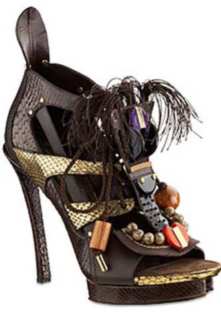
The New York Times ran a fashion article called “Out of Africa” about the Spring ’09 fashion season on March 30th. This article cited Louis Vuitton’s new “It” shoe , “Spicy”, Orlando Pitta’s sculpted hairdo s for Dior (which also featured “Africana” inspired shoes with fertility symbols carved into the heels), and Junya Watanabe’s “bold prints” as examples of “Africa chic”, which apparently the new hot trend with top designers these days.
s for Dior (which also featured “Africana” inspired shoes with fertility symbols carved into the heels), and Junya Watanabe’s “bold prints” as examples of “Africa chic”, which apparently the new hot trend with top designers these days.
This article is a great example of Lise Skov’s discussion of the colonialist gaze of journalists in “Fashion-Nation: A Japanese Globalization Experience and a Hong Kong Dilemma” from Re-Orienting Fashion: The Globalization of Asian Dress. The article even states, “the colonial world has also been mined for inspiration.” There is little to no acknowledgment in the article of the vast differences between the countries/regions of Africa that have been "mined", assuming that there is one grand aesthetic for all of Africa, a continent with millions of people. This discredits the historica l influences on dress in Africa, assuming that it is all what is "natural" for the people to wear, rather than influenced by distinct cultures, histories, and needs of the diverese peoples that live there.
l influences on dress in Africa, assuming that it is all what is "natural" for the people to wear, rather than influenced by distinct cultures, histories, and needs of the diverese peoples that live there.
As stated in “An Analysis of Modern Fashion Designs as Influenced by Asian Ethnic Dress” by Yu, Kim, Lee, and Hong, the West has adopted Eastern dress to fit Western lifestyle, not only in form but also in the way it is worn. The article concludes by noting, “the irony is that one step on African soil in this high and mighty footwear would probably bring even a hardened fashionista to her knees. Yet, in fashion, the dream creates desire.”
Appropriating certain styles without consideration of why they are used where they originated is why this conundrum results, in my opinion. Take, for example, lobe stretching, a recent trend in body modification that has been accepted by middle class youth across America. Lobe stretching in Africa is a symbol of community in many senses, connecting one's physical appearance with the traditions of one's tribe. In America, the practice has been appropriated to acheive the exact opposite purpose, seen as rebellion from the mainstream and an assertion of a deviant self. However, I am willing to bet that no suburban teen would take lobe stretching to the lengths (literal lengths of the lobe) of many African tribespeople, or to begin practice lip stretching or nostril stretching. It is also interesting to note that many African people practicing stretching often use seemingly Western objects (plastic cups, bottles) as stretching tools. Talk about recycling Western mass production!!!(assertations made here inspired by my reading of Victoria Pitts' "In the Flesh" for my research project)
For a great analysis of the New York Times article, visit the site Racialiscious.
Alison Tanner Entry #1

No comments:
Post a Comment